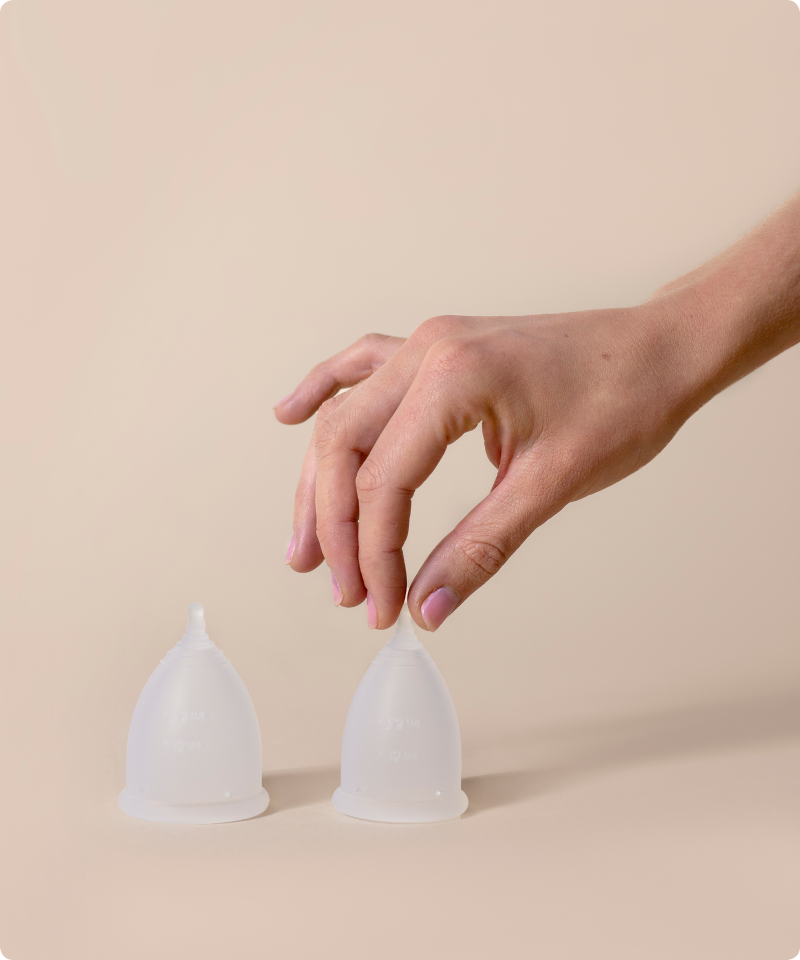Everything you need to know about endometriosis
Macron has announced a nationwide policy to address endometriosis in France, and many parties in the Netherlands are also doing their best to raise awareness of this, often painful, condition. And that’s very important!
So, what actually is endometriosis?
Endometriosis is a benign chronic gynecological condition in which cells similar to the endometrium, which are normally found only on the inside of the uterus, also occur outside the uterus. The most common site of these endometriosis cells is the abdominal cavity (on the peritoneum and organs in the lower abdomen). Sometimes, the endometriosis cells can also occur in the chest cavity (lungs), navel or in a scar from abdominal surgeries (think about a c-section, for example). These cells can grow and that can cause an inflammatory reaction with pain and adhesions... Although most women with endometriosis (can) get pregnant naturally, sometimes the adhesions or inflammations also cause difficulties in getting pregnant.
What is the cause of endometriosis?
The exact cause of endometriosis is very complex and there are several theories and even controversies about it. The exact cause is still unknown to this day. The female sex hormone estrogen plays a part, and in addition, researchers see that the immune system and genes also play a role in the development of endometriosis. Women who have mothers and sisters with endometriosis appear to be at a greater risk for endometriosis than women who don’t have endometriosis running in the family.
There are different kinds of endometriosis. Most women have a mild case of endometriosis (stage 1-2). These are small, shallow spots of endometriosis in the peritoneum. A small group of women has deeply invasive endometriosis, a form that grows into organs and tissues in the body.
The different stages of endometriosis
Read moreThe most common symptoms of endometriosis are:
(Chronic) abdominal pain
Extreme menstrual pain (before/during/after menstruation)
Pain during and after sex
Bowel and bladder problems (constipation, diarrhea, intestinal cramps, burning sensation when urinating)
Fertility problems
Pain during ovulation
Pain in (upper) legs and/or back during menstruation
Fatigue
Bloating (‘endo belly’)
There are people with stage 1-2 who experience a lot of (pain) symptoms and there are people with stage 3-4 who experience relatively little symptoms. The stage of endometriosis says nothing about the degree of (pain)symptoms.
Research shows that as a result of pain symptoms, people are often more prone to feelings of depression and dejection. Having (chronic) pain affects your mental well-being.
How do you diagnose endometriosis?
Endometriosis is in most cases discovered in women who have symptoms such as pelvic pain (30-60%) or unwanted childlessness (about 30%). Sadly, it still takes an average of 8 years to be diagnosed, because the symptoms are very diverse, thus making it difficult to recognize. Thankfully, there are several ways to diagnose endometriosis:
Anamnesis
Anamnesis is a different term for a patient-doctor interview. The doctor will ask you about your symptoms. This is an important part of arriving at a diagnosis.
Physical exam
When you go to your GP with symptoms and they refer you to a gynecologist, you’ll most likely get a physical examination. The examination consists of a pelvic examination (the gynecologist inserts their fingers into your vagina) and sometimes a rectal examination (through the anus). In addition, it may be necessary to look at the inside of the vagina with a speculum. This way, the gynecologist can sometimes feel or see the endometriosis spots. However, it is important that the doctor is experienced with this. A pelvic and rectal examination can be quite intense and severe. Discuss this with your doctor if you have any questions or if you are apprehensive about this.
Vaginal ultrasound
The gynecologist can also decide to do a vaginal ultrasound. To do this, a “rod” attached to a cord (which is attached to the ultrasound machine) is inserted vaginally. This is always done with lubricant to make it easier. Most women find this to be uncomfortable, but not painful. During the examination, the gynecologist assesses the organs in the pelvic region (the bladder, vagina, uterus, fallopian tubes, ovaries, rectum, and the pelvic floor). The disadvantage of doing a vaginal ultrasound is that as a doctor, you need to be experienced in finding endometriosis spots via an ultrasound, as endometriosis stage 1-2 can’t be seen via the vaginal ultrasound. Only stage 3-4 can be seen via a vaginal ultrasound. So, even if you can’t find anything on an ultrasound, that doesn’t mean that there isn’t anything there!
MRI
An MRI (magnetic resonance imaging) can be used to make a three-dimensional picture of your entire abdomen. That means that you can get a good look at everything around the organs. The disadvantage is that a lot of people can find it very exciting and claustrophobic. That’s because you have to lie very still in a sort of tunnel that makes a lot of noise. But generally, the hospital staff will guide you in this. Also, it’s not always possible to make an MRI quickly. You most likely will have to make a new appointment.
Laparoscopy (keyhole surgery)
With a laparoscopy, also called a keyhole surgery, the endometriosis spots can be visualized which aren’t visible with an ultrasound or an MRI. These are oftentimes very superficial spots, but they can cause a lot of symptoms! You’ll be placed under general anesthetic before a couple of small incisions are made around your navel. Then a small camera is inserted into your belly. With this camera, the doctor can look on the inside of your belly to see what’s going on. If the doctor sees any endometriosis spots, they can remove them immediately as well. During surgery, the tissue is cut or burned away with electrical current or ultrasound energy. The more that can be removed, the smaller the chance that endometriosis will come back just as strong, but the greater the chance of complications. The organs where endometriosis grows can be affected. Of course, the complications are first discussed by the gynecologist before you choose to get an operation and you will have to prepare yourself well for the surgery.
When the endometriosis spots can be identified, they are divided into different types:
Adenomyosis; a form of endometriosis in which the endometrium is in the muscle wall of the uterus. These usually cannot be removed, unless the entire uterus is removed.
Endometriomas; these are endometriosis cysts in the ovary. They can usually be found with an ultrasound or an MRI and the doctor will always discuss if these should and can be removed.
Superficial endometriosis(stage 1 and 2); this form of endometriosis, often found on the peritoneum, can be surgically removed.
Deeply invasive endometriosis (stage 3 and 4); This can occur in multiple spots, such as the bowel or bladder. Surgeries to remove these are complicated and the doctors will discuss the complications beforehand.
Linda (48) has severe endometriosis
Read moreWhich treatments are available for endometriosis?
Endometriosis is very annoying and can affect your daily life pretty severely. But, luckily it’s not life threatening. In most cases, women don’t even experience any endometriosis symptoms. They often find out, if they find out at all, that they have endometriosis when they want to have children. Treatment is only necessary when the endometriosis causes symptoms, such as severe pain or reduced fertility. There are several treatment options to reduce endometriosis. Sadly, it’s impossible to completely remove endometriosis.
Medication
Hormone treatment
The aim of administering medication is often to menstruate as little as possible, so that symptoms will be reduced. This can be achieved by continuously taking the pill, but also by using the Mirena IUD, Nuvaring, contraceptive injection, contraceptive patch or contraceptive implant. By influencing the female hormone levels with medication such as progesterone, which is in the pill, you’ll prevent ovulation. And this can calm down the areas where endometriosis grows. Only when the pill has no effect and the severe pain continues, will hormone tablets or injections be prescribed. These will keep you in an artificial and temporary perimenopause. We also call this GnRH agonists.
Synthetic hormones are the solution to a lot of people, but they can cause a lot of side effects as well. So, be well advised and if you get any side effects, discuss these with your doctor.
Pain relief
For women who can’t tolerate synthetic hormones, who don’t want those, or suffer from a lot of side effects, or if a combination treatment is proposed (for example, with hormone treatment), it is recommended to use paracetamol, naproxen and other pain relievers. The gynecologist will start with prescribing paracetamol and an eventual NSAID like naproxen. If that doesn’t work (sufficiently), then you can get some heavier painkillers. You can also be referred to a doctor specialized in (chronic) pain (doctor in the pain clinic).
Surgery
Sometimes surgery is recommended. This could be done via a laparoscopy where the endometriosis tissue is removed. The more complex forms of endometriosis sometimes require (major) abdominal surgery with other specialists. A definitive solution is a hysterectomy (removal of the uterus). It’s good to know that there is a possibility that not a 100% of your endometriosis symptoms will be gone after surgery.
Therapy
Endometriosis can have a massive impact on your life. From chronic pain symptoms to a child wish that is not (yet) fulfilled. Having someone to talk to can be really nice. This could be a friend, colleague, or a family member, but it could also be a licensed therapist. A psychologist or psychotherapist can be there for you and help you deal with your chronic pain or the sadness you’re feeling, for example. Cognitive behavioral therapy has proven to be effective in better managing chronic pain.
Pelvic floor therapy
A pelvic physiotherapist specializes in examining and treating the abdominal and/or pelvic (bottom) area A person with endometriosis may experience pain symptoms that cause high muscle tension in the pelvic floor. Often this happens unconsciously. A pelvic physiotherapist can make you aware of this and work with you to relax the pelvic floor more. This often reduces pain during peeing, pooping and sex.
Self-care
A portion of people with endometriosis do not benefit sufficiently from the above treatments and try things on their own to reduce their (pain) symptoms. Unfortunately, too little scientific research has been done into, for example, the influence of lifestyle on endometriosis symptoms, but many women respond positively to this. This is also shown in an Australian study.*
Nutrition
Eating healthy(ier) or following a diet can help sometimes. It can contribute to reducing bowel symptoms or just generally feeling healthier. Unfortunately, it hasn’t been proven that adjusting your diet will fix your endometriosis.
If you want to change your diet, always do this under the guidance of an expert or dietician. Otherwise, you run the risk of becoming deficient in certain vitamins & minerals.
Exercise and sleep
Moving slowly and sleeping well also helps to cope better with symptoms. It’s not just about getting 7 to 8 hours a night, but also about the quality of your sleep. Exercise doesn’t have to mean hitting the gym everyday, but it could also mean a quiet walk, yoga, or stretching, for example. High intensity workouts can have the opposite effect of what you desire.
Relaxation
Relaxation is different from sleep. Stress is a huge trigger and only increases your symptoms. Breathing and relaxation exercises can be used to positively influence the pain or perception of pain. Think about meditation, for example.
Heat
Yeah, we know! A hot bath or a hot water bottle or a warm blanket can give some relief with (pain) symptoms and cramps. If you do this, make sure to protect your skin so you don’t burn yourself!
Medicinal cannabis
A somewhat controversial topic because there is still little scientific evidence and it is (therefore) not on the standard list of gynecologists to prescribe: Hemp and CBD oil Australian research shows that the use of one of these products has a positive impact on pain symptoms. These reduce with (proper!) use.
Do you want to try this? If so, be well informed by an expert. The Transvaal pharmacy in The Hague, for example, deals with medicinal cannabis and there is a special phone line for patients. They can then help explain CBD oil and a combination of CBD and THC and how to use it. There are also several websites that have information that could help. You can get CBD oil in stores (buy a good quality one!) but CBD with THC is only available with a doctor's prescription. Often people first start with a "full spectrum CBD oil" that you take dosed over the day. It is good to know that these are not covered by your health insurance.
Do you have (severe) pain or have you been trying to conceive for a long time, but have still not succeeded after a year? Then it might be wise to listen to your body and visit your GP. They can refer you to a gynecologist.
Sources: https://www.ncbi.nlm.nih.gov/pmc/articles/PMC6332532/ , https://cannakeys.com/thc-cbd-for-endometriosis-and-adenomyosis/



























